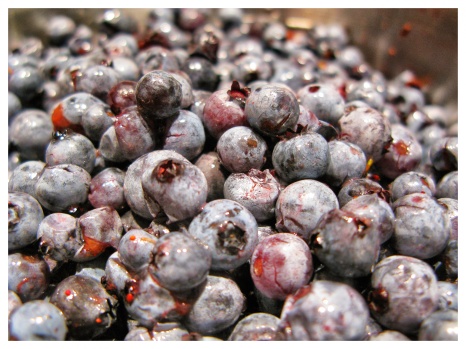I love okra a lot. I almost constantly crave the seductively silky slime that oozes between the bright bubble-like seeds of the tender pod. There’s really nothing else like the texture of good, young, fresh, homegrown okra. So when I saw it for $3.50 a pound at Greensgrow’s Saturday market (try $8 at some other farm stands) I was all over it. Nice combo of pretty green and purple varietals with dainty pods, which is good when you’re talking okra. The longer the pod, the more likely it has grown woody. These, though, looked perfect.
If my description of okra’s many fine qualities has you grimacing with disgust, keep in mind that it also happens to be a nutritional powerhouse, especially when it comes to healthy digestion. The mucilaginous fiber contained in the pods is like compost for your poop. It bulks, greases, detoxes, feeds your healthy probiotic gut bacteria…intestine heaven. Look out for a blast of vitamin C, folate (a B vitamin that your red blood cells love), calcium and potassium too. And with almost no accompanying calories, fat or cholesterol, this superfood is a golden ticket to health, weight loss, happiness, and, at $3.50 a pound, a fatter wallet too.
What better way to enjoy a superfood than with roots. And those aren’t hard to come by for this little “finger” food. Okra is a dietary staple from West Africa through the Sahara and across Asia to Japan. It’s been part of local cultures for centuries…defining textural tastes (neba neba!)…thickening traditional dishes (gumbo’s got roots too)…supposedly even keeping Cleopatra’s skin free and clear of any unsightly acne. Cool.
When it came time to turn my okra into dinner, I was so exhausted from lugging 40 lb bags of mushroom poop up three flights of stairs to my third story garden that all I could possibly take on was something relatively fast and super simple. West Africa fit that bill. Across this largely tropical coast, history and ecology have produced rich and entirely unique cuisines that also happen to rely on very few available resources and ingredients. Simple food. And sometimes fast.
Born was this uncomplicated and somehow deeply flavorful stew roughly based on the many varieties of ancestral gumbo cooked throughout West Africa, especially Senegal and Nigeria. It was claimed that this may have been the best thing I have cooked in the past six months. And not by me. A great home for a great fruit.
NOTE: I would seriously encourage you to orchestrate some homemade stock into this dish. As with all simple cooking, it’s the quality of the ingredients that truly matters.
West African Okra & Fish Stew
so easy, very healthy
serves 2 as a meal, 4 as not really a meal
- shrimp stock (or any other stock) — homemade
- pint or so okra, sliced into rounds — Greensgrow
- kale (or any hearty green), roughly chopped — Fountain Farmers’ Market
- white or yellow onion. roughly diced — Fountain Farmers’ Market
- white stock fish (I used tilapia cause it’s what they had, but red snapper or mackerel might be better), rinsed and cubed — Whole Foods
- peanut butter — Trader Joes
- bay leaf — Whole Foods
- cayenne (or red pepper flakes) — homeground
- lime — El Zarape Grocery Store
- large yam — Whole Foods
- Get started: in large soup/stock pot bring 4 cups stock, onion, bay leaf and okra to boil and let simmer for 10 minutes or until okra is softened but not mushy
- Meanwhile: boil yam until soft and then mash, with skin on
- Add other stuff: add 2ish tbs of peanut butter, a light dash of cayenne or red pepper and chopped greens
- Add fish: once greens are wilted and soft after about 5 minutes add fish cubes and continue to cook until just opaque, about 3 minutes
- Serve: squeeze lime over soup, serve with mash yam























